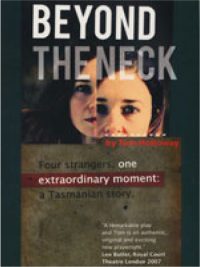RECOMMENDED FOR: Tertiary students
CAST SIZE: 2M, 2F, 1 Visitor (ages 7, 17, 28 and 75)
A PLAY TO: Read, read aloud, study, perform, as stimulus for making and creating
GENRE: Verbatim, drama
THEMES: Grief, loss, resilience
CURRICULUM/STUDY LINKS: Dramatic form and structure, contemporary Australian theatre, Verbatim theatre
SYNOPSIS: An old man falls into his wife’s arms and cries. A young mother drops a pile of washing on the floor. A teenage girl as a child tells her mother the news. A boy walks home in silence. He feels the blood run down his cheek. The four strangers are bound by a shared moment – the Port Arthur Massacre. Ten years on and the aftershocks of the event still ripple.
Based on in-depth interviews, Beyond the Neck is set ten years after Port Arthur event and deals with the grief and recovery of the 1996 tragedy when Martin Bryant shot and killed 35 people and wounded over 20 more at Port Arthur on the Tasman Peninsula in Tasmania/lutruwita.
STAGING: Before each performance the cast and crew should offer tea and biscuits or similar to the audience without charge. Not in the sense of an emergency centre, but purely to give something away for free.
This piece of theatre is perhaps closer to a musical quartet than to a ‘straight’ play. It is a piece where rhythm and timbre play vital roles, perhaps equally as important as characterisation and narrative structure. The actors in this play have two main functions. The first is to voice the story of their characters and the second is to work as a broken chorus in support of each other’s journeys.
There are times when members of the chorus urge the character to tell their story, times when they ‘fill in the gaps’ and times when they work in direct opposition to the character. This is similar to the four instruments of a quartet. At times each actor has the main theme of the piece (they hold the ‘tune’ as their character) and at other times they work either in support of or as a counter to the theme (as the chorus). As with a piece of music the full effect of is not clear until all four parts can be heard and seen working together (from Note to Actors and Director).

